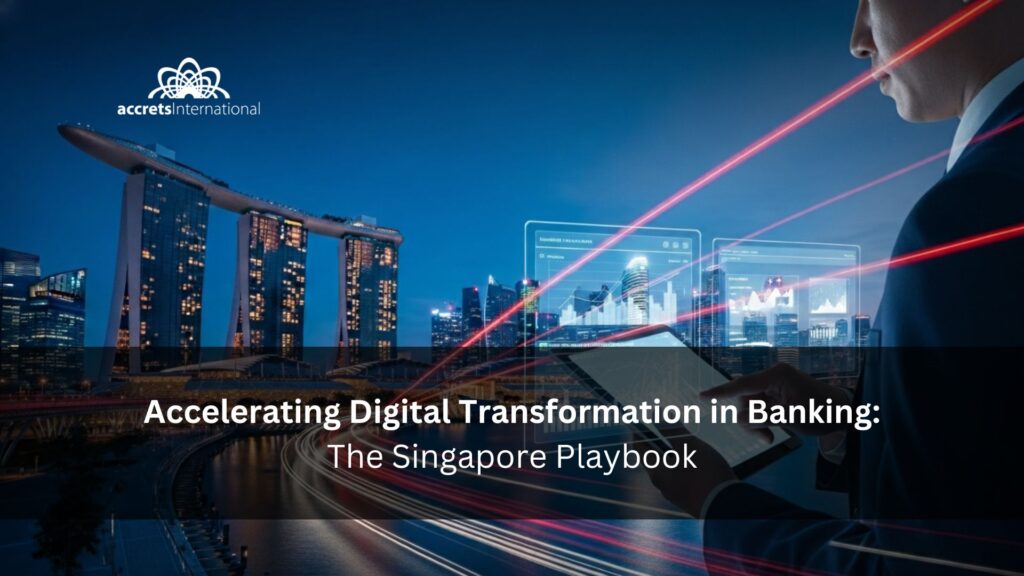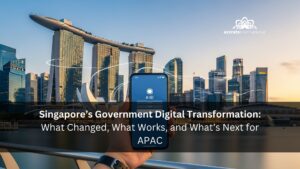This article gives Singapore banks a practical, MAS-aligned playbook for accelerating digital transformation in banking. In short, set a clear operating model, build a modern digital core, and govern for speed, then ship three high-value journeys in 3 to 6 months. We will walk through the steps, metrics, and decision frameworks together, so let’s read this to the end.
Table of Contents
ToggleSummary in 90 seconds
- Organisation: Platform squads aligned to customer journeys, clear product and tech co-leadership, empowerment within guardrails.
- Technology: Establish a digital core with a cloud landing zone, governed data, and AI foundations that let pilots scale.
- Governance: Treat MAS requirements as accelerators by designing for technology risk, model risk, data residency, and resilience from Day 0.
If regional scaling or latency is a factor, Singapore’s hub advantages matter. For context on siting workloads, see this overview of Tier-2 data centres in Southeast Asia and why Singapore often wins. For a wider sense of national momentum, consider how the public sector advanced in Singapore’s government digital transformation.
What “accelerate” really means for SG banks
Define speed with measurable targets you can run a programme against:
- Time to market: idea to first production release in 90 to 120 days for a focused journey such as onboarding or payments.
- Deployment frequency: move channels from quarterly to weekly or daily, and core-adjacent services to monthly.
- Digitisation coverage: percent of priority journeys that are truly end to end, including exceptions.
- Cloud mix: percent of targeted workloads landing in a compliant cloud with agreed data controls.
- AI lead time: idea to governed go-live for an AI use case such as a relationship manager copilot.
- Resilience: RTO and RPO tested and matched to business criticality. For continuity patterns and exercises, this primer on cloud providers for backup and disaster recovery in Singapore pairs well with a simple approach to IT infrastructure capacity planning.
The MAS-aligned acceleration map
Day 0 to 30: Decide and design for speed
- Scope 2 to 3 journeys with clear value such as PayNow and FAST enhancements, SME e-KYC, or wealth RM workflows.
- Stand up a cloud landing zone with identity, network, logging, secrets, and data classification.
- Governance upfront: document data residency needs, third-party risks, and model-risk guardrails before pilots. For workloads that intersect public sector or regulated paths, understand options like GCC in Singapore.
- Define KPIs: time to market, release cadence, adoption, model approval SLAs.
Day 31 to 90: Ship the first slice
- Choose coexistence patterns such as an API facade or strangler to limit blast radius.
- Deliver the walking skeleton of one journey to production and iterate.
- Ensure model risk hygiene with data lineage, bias tests, and human-in-the-loop. Expectations on governance trade-offs are outlined in navigating AI model governance in 2025.
Day 91 to 180: Scale the second and third journeys
- Parallelise squads, backed by shared platform services such as auth, CI or CD, and observability.
- Harden operations with SRE practices, error budgets, DR rehearsals, and immutable backups.
- Treat key datasets as products, with owners, SLAs, and access controls.
Day 181 to 365: Industrialise
- Expand to 6 to 10 journeys with a steady release cadence.
- Optimise cost and performance with FinOps guardrails and automated rightsizing.
- Drill compliance and resilience. If you specify availability targets, align designs with primers on Tier-3, Tier-4, and Tier-5 facilities.
Decision framework: coexist vs replace vs adopt-and-build
Pick the least-regret path per domain such as channels, payments, core, and analytics.
- Coexist around legacy
When: value needed in under 6 months, legacy risk is high, budget is tight.
Pros: fastest initial time to market, minimal disruption, easier approvals.
Cons: some duplication and technical debt.
Governance load: moderate, focus on API contracts and access controls.
Best for: channel modernisation, payments overlays, analytics. - Replace the legacy system
When: end-of-life or untenable risk, and a long runway is acceptable.
Pros: clean architecture, long-term agility.
Cons: higher risk and longer time to market.
Governance load: high, especially around migration and parallel runs. - Adopt-and-build on a platform
When: you need speed with room for differentiation.
Pros: faster than pure build and more flexible than pure buy.
Cons: vendor management and architectural fit must be handled.
Governance load: moderate to high with clear shared responsibilities.
If outsourcing is part of your acceleration plan, align expectations early using this plain-English explainer on what IT outsourcing services include and how an infrastructure IT outsource service in Singapore typically sculpts responsibilities and SLAs.
Fast architecture patterns
API facade
Use when you need consistent APIs for mobile and web without touching legacy immediately.
How it accelerates: channel teams can iterate independently, while the facade composes or caches responses to hide backend inconsistencies.
Watch-outs: rate limiting, data freshness, and versioning.
Regional note: when journeys cross Mainland China or ASEAN corridors, low-latency routing matters. See Teridion’s cross-border approach for China and broader enterprise connectivity.
Strangler pattern
Use when you are incrementally replacing parts of a legacy core.
How it accelerates: retire capabilities slice by slice while keeping the lights on.
Watch-outs: identity mapping, data consistency, and parallel run complexity.
Hybrid tip: many banks keep some workloads on-prem for latency or data concerns. This guide to hybrid cloud providers in Singapore outlines common patterns.
Event backbone
Use when real-time is critical for payments, fraud, AML, and telemetry.
How it accelerates: decouples producers and consumers so new use cases can be added without altering the old.
Watch-outs: PII governance in motion and at rest, schema evolution, and access control.
Operating model that speeds delivery
Technology rarely outruns org design. Patterns repeatedly seen in successful Singapore programmes include:
- Platform squads with journey ownership for areas like payments APIs or SME lending.
- Two-in-a-box leadership where product and tech co-lead scope and speed with short escalation paths.
- Empowerment with guardrails for budgets, SLAs, and risk thresholds, with security embedded in squads.
- An upskilling plan for product managers, SRE, data engineers, and risk partners.
When bandwidth is constrained, steady-state support and surge capacity help. For context, this decision-maker’s guide to business IT support in Singapore shows typical approaches to keeping operations solid while modernisation proceeds.
Digital core: data, cloud, and AI governance that do not slow you down
Build a foundation that makes the second and third launches faster than the first:
- Cloud landing zone with identity, segmented networks, golden images, logging, cost controls, and approvals.
- Trusted data products with owners, SLAs, lineage, and access policies.
- AI guardrails such as model inventories, evaluation methods, bias tests, human oversight, and approval workflows.
- Observability and SRE with standard metrics, tracing, and error budgets, plus blameless postmortems.
- FinOps for spend visibility and unit economics.
For banking-specific context, see a regional overview of cloud banking solutions in Singapore and Southeast Asia. Security and audits are stronger when specialists are engaged early. This primer on cloud security consulting in Southeast Asia outlines typical control stacks. If you are choosing building blocks, these vendor-neutral explainers help: advantages of infrastructure-as-a-service, a view of IaaS vendors, and the difference between platform and infrastructure as a service.
For resilience, align runbooks with proven patterns in backup and DR for Singapore workloads. When public cloud is not viable, weigh what private cloud hosting services mean in 2025.
Lessons learned from DBS, and how to replicate it:
- Platform boundaries matter. Define shared services such as identity, payments, and data with product owners and SLAs.
- Journey KPIs beat project checklists. Measure cycle time, adoption, and risk outcomes rather than only stage gates.
- Product and engineering co-lead. Push decisions down and resolve scope or speed locally.
- Data and AI scale only with governance. Lineage, evaluation, and approvals make later launches faster than the first.
For mid-tier institutions, start narrower with one or two journeys, overlay common platform services, and expand squads only when metrics show the flywheel is spinning.
Prioritising the first three journeys
Use a four-factor scorecard to decide what ships first:
- Regulatory heat such as cross-border data, AML or KYC, and model risk.
- Revenue lift from new accounts, deposits, fee income, or cross-sell.
- Opex reduction from straight-through processing and fewer manual touches.
- Data availability that is clean and timely enough for outcomes.
Examples include payments overlays that enhance PayNow and FAST experiences, digital onboarding for retail and SMEs using e-KYC and e-KYB, and wealth RM assistance with guided workflows and an AI copilot. Supporting infrastructure often determines feasibility. The broader enterprise stack in Singapore is outlined in a corporate IT infrastructure blueprint for mid-size enterprises, and mission-critical journeys should align with Singapore-specific backup and disaster recovery guidance.
Field metrics and ROI to target in 3 to 12 months
- 0 to 3 months: first journey live, weekly releases, error budgets defined, adoption trending up.
- 3 to 6 months: second and third journeys live, daily channel deployments, first AI use case in production with approvals.
- 6 to 12 months: 6 to 10 journeys live, unit cost down, NPS up on digitised journeys, and a growing share of targeted workloads running in cloud with standardised runbooks and DR exercises completed.
Risks and mitigations
- Data residency and sovereignty: separate control planes from data planes, classify data early, and document cross-border access paths.
- Vendor lock-in: secure exit paths and data portability in contracts, use containers and infrastructure as code where appropriate, and benchmark alternatives in this guide to VMware alternatives.
- Resilience: test failovers, design for multi-AZ, and keep immutable backups. If you are exploring brokered multi-cloud or portability across vendors, these principles are helped by understanding the interoperability of inter-cloud services across different platforms and how a brokered model sometimes marketed as a cloud service broker works.
Conclusion and next step
To accelerate in Singapore, identify your programme phase, choose the least-regret path per domain, and ship three value-creating journeys with MAS-aligned guardrails from the start. Use the metrics above to keep score, and iterate as you scale. If you want a quick discussion tailored to your environment, you can fill the form for a free consultation with an Accrets Cloud Expert for accelerating digital transformation in banking via the Accrets contact page.
For optional reading about partner capabilities, see managed cloud service provider, a summary of why Accrets, core IT infrastructure, cloud infrastructure-as-a-service, enterprise cloud computing, a cloud service broker, managed backup services, IT DR-as-a-Service, on-premise private cloud, enterprise connectivity, Teridion connectivity to China, IT implementation services, and steady-state managed IT services.
Dandy Pradana is an Digital Marketer and tech enthusiast focused on driving digital growth through smart infrastructure and automation. Aligned with Accrets’ mission, he bridges marketing strategy and cloud technology to help businesses scale securely and efficiently.




